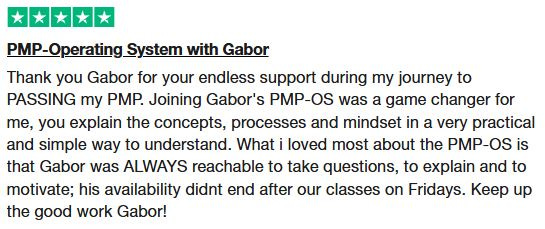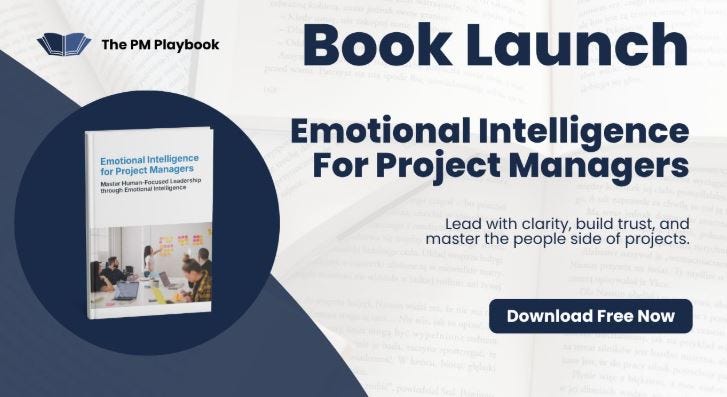How to Transform Project Health in 4 Steps (AI Included!)
9 Harsh truths I learned about project management
Welcome to the Agile Admiral weekly newsletter. Your Essential Resource for Project Management Excellence.
Each week, I tackle reader questions about PMP preparation, how to implement PMP into real-life projects, and a Senior Project Manager career.
For more: Project vs. Change Management | The Chaos Coordinator | The Project Habit You’re Probably Skipping | When Projects turn RED | Macro vs Micro Goals for PMs | PM without authority is just a punching bag with a calendar |
What's Inside This Edition:
9 HARSH TRUTHS I LEARNED ABOUT PROJECT MANAGEMENT (The Hard Way)
How to Transform Project Health in 4 Steps (AI Included!)
FREE Book - Emotional Intelligence for Project Managers
Newsletter: PMP-Daily // 8 -week Study Plan Workshop - June 18 // PMP Operating System
9 HARSH TRUTHS I LEARNED ABOUT PROJECT MANAGEMENT (The Hard Way)
No certification prepared me for these.
1. Clear communication assumptions
Misunderstandings cost more than mistakes. When team members operate on different assumptions, they waste time building the wrong things or solving problems that don't exist. The cost of clarifying upfront is always less than the cost of rework.
2. Following up isn’t micromanaging
It’s how you keep momentum alive. The difference between following up and micromanaging is trust—you're checking on the work, not controlling how it gets done.
3. Minor delays become major problems
Every “it’s just a day” adds up. Small delays create cascading effects that compound throughout a project timeline. What seems manageable in isolation becomes a crisis when you realize five "small delays" have pushed your milestone back three weeks.
4. If you don’t measure it, it won’t improve
Data drives accountability, not dashboards. Metrics without action are just pretty charts that make people feel busy. The real power comes from using data to have honest conversations about performance.
5. The team watches how you handle pressure
And that’s what they copy. Your response to stress, setbacks, and difficult decisions becomes the template for how your team will handle similar situations. If you panic, blame others, or make rash decisions under pressure, you're teaching your team to do the same.
6. Tools can’t fix broken teams
Slack can’t replace trust. Technology can improve efficiency, but it can't solve fundamental issues like poor communication, lack of accountability, or conflicting priorities.
7. Silence isn’t agreement
Check in. Ask. Dig deeper. When people stop speaking up in meetings or responding to requests for feedback, it often means they've disengaged or disagree but don't feel safe expressing it.
8. Saying “no” is leadership
You’re not just protecting the scope — you’re protecting your people. Every "yes" to a new request is a "yes" to overtime, stress, and potentially compromised quality for your team. Strong leaders understand that their primary job is to shield their team from unrealistic demands so they can do their best.
9. Conflict is healthy — avoidance is expensive
Unspoken tension always shows up… later, and louder. Disagreements that get swept under the rug don't disappear—they eventually explode at the worst possible moment, often during critical project phases. Addressing conflict early allows teams to find solutions while emotions are manageable and options are still available.
How to Transform Project Health in 4 Steps (AI Included!)
Introduction
Hi Agile Admirals,
Ever feel like you're navigating your projects in the dark? You're not alone. Project health is critical, yet many teams struggle to clearly see where they're heading. This week's issue of Agile Admiral dives deep into practical strategies to transform your project's health using innovative tools and proven techniques. We'll unpack how to leverage AI, enhance clarity, and ultimately reclaim control. Ready to turn your project chaos into clarity?
Featured Article: Transforming Project Health—Step by Step
Why Project Health Matters (And Where Most Teams Fail)
Picture this: You're driving without headlights—dangerous and stressful. That's exactly how it feels managing projects without clear indicators of their health. Project health isn't just tracking tasks; it’s about visibility, proactive management, and strategic decision-making.
Step 1: Establish Clear, Meaningful Metrics
Avoid metric overload by focusing on the essentials: schedule variance, cost performance, team satisfaction, and risk exposure. Keep it simple yet strategic. For instance, tracking schedule variance can immediately alert you to potential delays.
Step 2: Integrate AI for Predictive Insights
AI isn’t here to replace your judgment—it’s here to amplify it. Tools like predictive analytics can forecast delays or budget overruns before they become critical, allowing proactive management rather than reactive firefighting.
Step 3: Make Your Dashboards Actionable
Dashboards shouldn't be data dumps. They should guide decision-making. Clearly visualize key metrics and include actionable prompts—like suggesting immediate steps when a risk level crosses a threshold.
Step 4: Prioritize Transparent Communication
Project health thrives on transparency. Regular, clear communication ensures alignment and trust within your team and stakeholders. Consider weekly stand-ups focused explicitly on discussing project health indicators.
Actionable Takeaway:
Audit your current project metrics: Are they clear and actionable?
Evaluate AI tools suited for predictive analytics relevant to your projects.
Redesign your dashboards to prompt clear actions.
Commit to a transparent communication schedule.
Industry News Roundup
AI in Project Management: Gartner predicts that by 2026, 60% of PM software will incorporate AI capabilities, significantly enhancing decision-making and risk management.
Overstrain Alert: Recent studies highlight increased burnout among project managers due to overwhelming data demands. Prioritize automation and clear metrics to manage workload effectively.
Quick Tips Section
Simplify Metrics: Choose 3-5 KPIs that genuinely reflect your project health.
Use AI Wisely: Automate routine monitoring tasks to free up cognitive bandwidth.
Routine Check-ins: Implement brief daily or weekly meetings focused solely on project health.
Resource Spotlight
Book Recommendation: "Measure What Matters" by John Doerr Transform how you set goals and measure progress with this practical guide on OKRs—perfect for aligning your team’s health metrics with strategic goals.
Personal Insights
Last month, my team struggled with project transparency. After introducing a simplified AI-driven dashboard, clarity improved immediately. Team confidence soared, highlighting that complexity is rarely the solution. Clear, focused tools and open communication are the true game-changers.
Call-to-Action
Found value in this issue? Drop a comment sharing your biggest takeaway or tag a colleague who could benefit. Join our Agile Admiral community now to keep transforming your projects week after week!
Sign-Off
Stay agile,
Agile Admiral
Your weekly dose of clarity and agility in project management.
Did you know?
Daniel Hemhauser just published: 📘 𝗙𝗿𝗲𝗲 𝗕𝗼𝗼𝗸 𝗳𝗼𝗿 𝗣𝗿𝗼𝗷𝗲𝗰𝘁 𝗠𝗮𝗻𝗮𝗴𝗲𝗿𝘀
Thank you for reading. Appreciate you!












